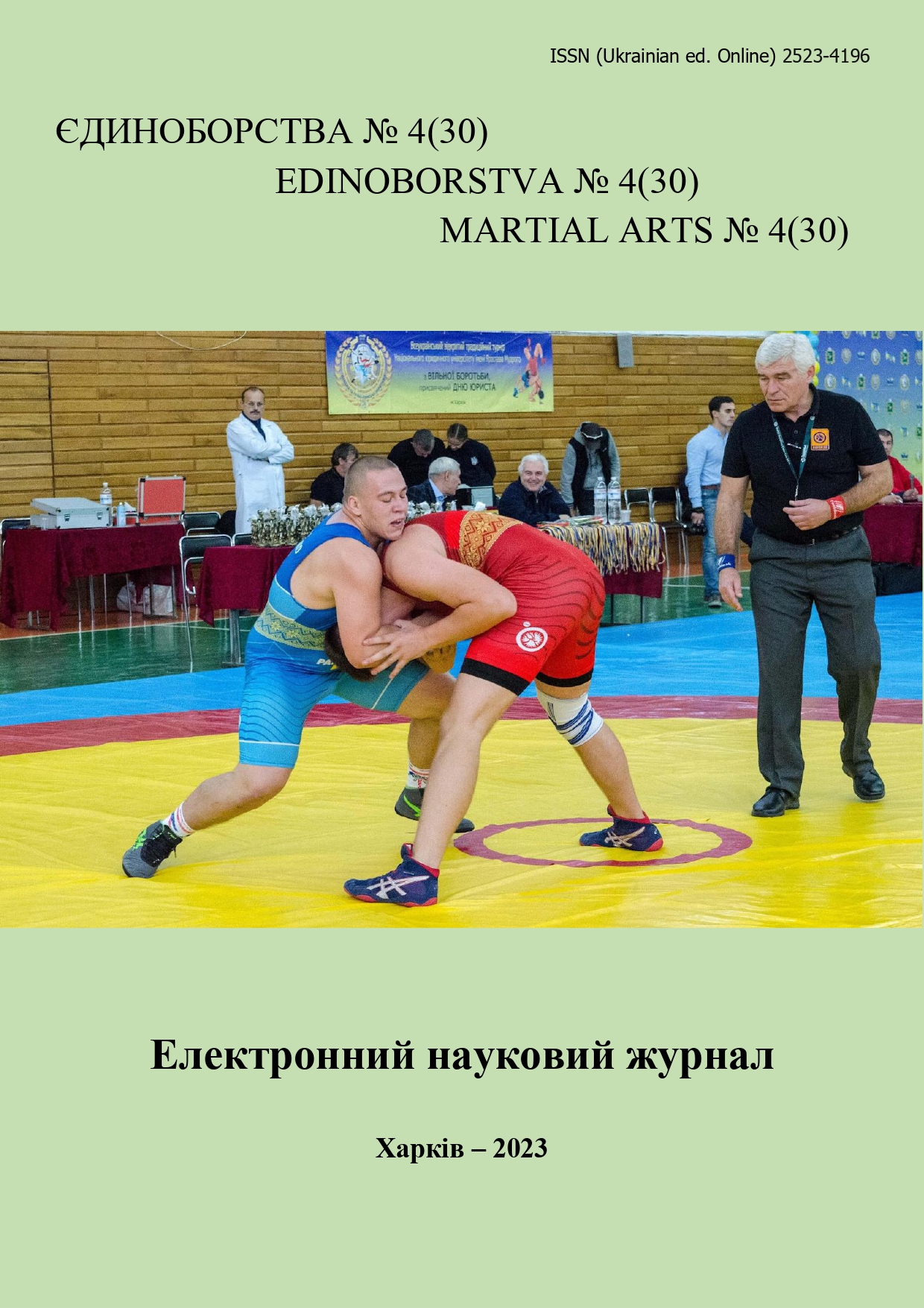Дослідження сенсомоторних реакцій каратистів 10-13 років
DOI:
https://doi.org/10.15391/ed.2023-4.03Ключові слова:
сенсомоторика, психофізіологія, карате, початківець, дослідженняАнотація
Мета: визначити рівень сенсомоторних реакцій каратистів 10-13 років. Матеріал та методи. У даному досліджені використано наступні методи дослідження: теоретичний аналіз і узагальнення наукової та методичної літератури; педагогічне спостереження; психофізіологічні вимірювання; математико-статистичні методи дослідження. У дослідженні приймали участь каратисти-юніори спортивного клубу «Центуріон», м. Харкова, у кількості 26 спортсменів, яких було поділено на 2 групи по 13 чоловік за віковим критерієм. Перша група каратисти 10-11 років, друга 12-13 років. Для визначення рівня прояву сенсомоторних реакцій було використано комплекс спеціальних програм для планшетних комп’ютерів під керівництвом iOS. Були отримані результати сенсомоторних реакцій спортсменів, що досліджувались за такими тестами: TestSTMemory (короткочасна зорова пам’ять); Visuomotor Choice Reaction (реакції вибору); Reaction RMO (реакції на об’єкт, який рухається); TappingPro (кількість та тривалість натискань протягом 1-ї хвилини). Результати: тривалість сенсомоторної реакції є одним із нейрофізіологічних показників. Це найпростіший, доступніший і водночас дуже точний нейрофізіологічний показник. Він відображає швидкість нейронних процесів та їх перемикання, рухову координацію, загальну працездатність та динаміку діяльності центральної нервової системи. Аналіз отриманих результатів дослідження показав, що каратисти 10-11 років мають на 13 % менше об’єму сприйняття, ніж каратисти 12-13 років. Старші каратисти краще запам’ятовували та швидше проходили тестування, через те, що ця когнітивна діяльність пов’язана з запам’ятовуванням положень супротивника та диференціювання прихованих сигналів перед руховими діями. Реакція вибору більш старших спортсменів на 26 % більша та це є свідченням того, що каратисти 12-13 років більш досконало володіють механізмом керування рухами. Реакція на об’єкт, що рухається у спортсменів старшого віку точніша на 52 %. В теппінг-тесті каратисти старшого віку робили на 11 % більше натискань через більш високу кваліфікацію та фізіологічний розвиток. Отримано статистично достовірні показники в тестах за критерієм Вілкоксона - «Реакція вибору», «Короткочасна зорова пам’ять» та «Реакція на об’єкт, що рухається». Результат старших спортсменів в «Теппінг-тесті» краще, але не є статистично достовірними (р>0,05). Кращі результати більш старших спортсменів в інших тестах пов’язані зі зростанням обсягу спеціальних вправ, а саме вправ з елементами єдиноборства. Висновки. Вище перелічені тести можна використовувати в тренувальному процесі каратистів для визначення психофізіологічних особливостей, адже згідно аналізу та порівняння отриманих даних в тестах «Реакція вибору», «Короткочасна зорова пам’ять» та «Реакція на об’єкт, що рухається» у старших каратистів спостерігається статистично достовірно кращі показники ніж у молодших спортсменів (p<0,05). Це пов’язано зі зростанням обсягу спеціальних вправ у спортсменів старшої групи, а саме вправ з елементами єдиноборства.
Посилання
Ашанин, В.С, & Романенко, В.В. (2015). Використання комп’ютерних технологій при оцінці сенсомоторних реакцій в однобортвах. Слобожанський науково-спортивний вісник, No4 (48), 15-18.
Байбіков, М.А., & Романенко, В.В.(2023). Дослідження методів оцінки психомоторних здібностей в єдиноборствах. Єдиноборства, 2 (28), 4-14. DOI:10.15391/ed.2023-2.01
Бойченко, Н.В., Алексєнко, Я.В., & Алексєєва, І.А. (2015). Інноваційні технології в системі підготовки єдиноборців. Єдиноборства, 1,25-27.
Вовканич, Л. (2015). Особливості сенсомоторних реакцій спортсменів різних спортивних спеціалізацій. Фізична активність, здоров’я і спорт, 2 (20) 17-26.
Воронова, В.И., Федорчук, С.В., Тукаєв, С.В., Лисенко, Е.Н., & Шинкарук, О.А. (2017). Психофізіологічний стан спортсменів з різним рівнем особистісної та ситуативної тривожності в складнокоординаційних видах спорту. Спортивна медицина і фізична реабілітація, № 1, 26-32.
Голяка, С.К. (2005). Властивості нейродинамічних та психомоторних функцій у студентів з різним рівнем спортивної майстерності (Автореф. дис. … канд. біол. наук). Херсон, Україна.
Дакал, Н.А. (2015). Психофізіологічні особливості елітних атлетів з урахуванням стилю ведення поєдинку. Теорія і методика фізичного виховання і спорту, 1, 114-117.
Дегтяренко–Мельник, Т.В., & Бринза, І.В. (2023). Психофізіологія. Навчальний посібник, Одеса.
Козіна, Ж.Л., Барибіна, Л.Н., Міщенко, Д.И., Цигунов, А.А., & Козин А.В. (2011). Програма «Психодіагностика» як засіб визначення психофізіологічних особливостей і функціонального стану в фізичному вихованні студентів. Физическое воспитание студентов, 3, 56-59.
Коробейніков, Г.В. (2004). Психофізіологічні властивості спортсменів складнокоординаційних видів спорту. Фізичне виховання і спорт у сучасних умовах, 160–167.
Коробейніков, Г.В., Дудник, О.К., Коняєва, Л.Д. ... & Радченко, Ю.А. (2008). Діагностика психофізіологічних станів спортсменів. Методичний посібник. Київ.
Макаренко, М.В., Лизогуб, В.С., Голяка, С.К. Безкопильний, О.П., & Спринь, О.Б. (2008). Особливості властивостей психофізіологічних функцій у спортсменів із різним рівнем спортивної кваліфікації. Спортивна медицина, (1), 174–180.
Малхазов, О.Р. (2002). Психологiя та психофiзiологiя управлiння руховою дiяльнiстю. Монографія. Євролiнія, Київ.
Романенко, В.В., & Ровний, А.С. (2016). Модельні характеристики сенсомоторних реакцій і специфічних сприйняттів одноборців високої кваліфікації. Єдиноборства, 1, 54-57.
Романенко, В.В., Голоха, В.Л., & Веретельникова, Н.А. (2018). Оцінка і аналіз підготовленості кваліфікаційних тхеквондистів. Єдиноборства, 1,58-69.
Тропін, Ю., Веретельникова, Н. & Панов, П. (2021). Дослідження прояву реакції вибору єдиноборців після виконання вправ з тенісними м’ячами. Єдиноборства, 2 (20) 71-82. DOI:10.15391/ed.2021-2.06
Curby, D., & Tropin, Y. (2019). Differences in manifestation of sensory-motor reaction sand specific perception satthe men and women doing martial arts. Edinoborstva, 2(12),68-78. DOI:10.5281/zenodo.2544684
Iermakov, S., Podrigalo, L., Romanenko, V., Tropin, Y., Boychenko, N., & Rovnaya, O. (2016). Psycho-physiological features of sportsmen in impact and throwing martial arts. Journal of Physical Education and Sport, 16(2), 433-441.
Podrihalo, O., Romanenko, V., Podrigalo, L., Iermakov, S., Оlkhovyi, O., Bondar, A., ... & Galimskyi, V. (2023). Evaluation of the functional state of taekwondo athletes 7-13 years old according to the indicators of the finger-tapping test. Slobozhanskyi Herald of Science and Sport, 27(1), 3-9. DOI:10.15391/snsv.2023-1.001
Romanenko, V., Piatysotska, S., Tropin, Y., Rydzik, Ł., Holokha, V., & Boychenko, N. (2022). Study of the reaction of the choice of combat athletes using computer technology. Slobozhanskyi Herald of Science and Sport, (4), 97-103. DOI:10.15391/snsv.2022-4.001
Fedorchuk, S., Lysenko, O., Kolosova, O., Khomyk, I., Ivaskevych, D., & Tukaiev, S. (2020). Assessment of the risk of injury to athletes in connection with psychophysiological indicators (skiing). Sport Science and Human Health, (2 (4)), 141-153.













